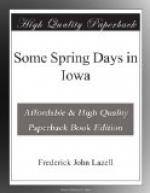* * * * *
But we have lingered too long among our flowers and thoughts in the April woods. The filmy haze which veiled the sun has thickened into threatening clouds, and as we look across the meadow to where the silver blue haze rested on the delectable mountain in the morning we see instead the rain-fringe, veiling and obscuring the landscape. The wind has died to a dead calm and the river is still. As the shower comes nearer the whole landscape is shrouded in an ever darkening gray and presently big round drops splash upon the surface of the river. In a moment we are surrounded by the rain. How beautiful is the first spring rain! It does not run down the slope as in the winter when the ground was frozen, but the thirsty earth seems eager to drink every drop. The unfolding leaves of the shrubs are bathed in it and the tender firstlings of the flowers are revelling in it. It dims the singing of the birds, but the robins and the meadow larks carol on and the spring music of the frogs in the nearby pond has not yet ceased.
What makes the raindrops round? And why are the drops at the beginning of the shower much larger than those which follow? We do not know. Perhaps it is well. Walt Whitman says that “you must not know too much or be too scientific about these things.” He holds that a little indefiniteness adds to the enjoyment, a hazy borderland of thought as it were, like that which rests in April mornings on enchanted highlands away across the river, which we have never yet—as Thoreau says—“tarnished with our feet.”
And, anyway, before we can reason it out, the rain has ceased and the last rays of the descending sun come through an opening in the clouds in that beautiful phenomenon known as a “sunburst.’[TN-3] The white beams come diagonally through the moisture-laden air, as if in a good-night smile to the tender flowers and buds.
Warming with the sunshine and watering with the showers—that is Miss April making her flower garden grow.
MAY—PERFECTION OF BEAUTY
V. MAY—PERFECTION OF BEAUTY
Among the changing months May
stands confessed
The sweetest and in fairest
colors dressed.
—THOMSON.
Surely the poet sang truly. We would not forget Lowell’s challenge “What is so rare as a day in June,” but as we sit here on the top of a limestone cliff nearly a hundred feet above the bed of the creek, and watch the red sun brightening the gray of the eastern sky, while the robins and the meadow larks are singing joyous matins we steep our senses in the delicate colorings of earth and sky that signalize the awakening of another day and the real revival of another year. April was encouraging, but there were many bare boughs and many of the last year’s leaves still clung to the oaks and made a conspicuous feature of the landscape. The leafy




